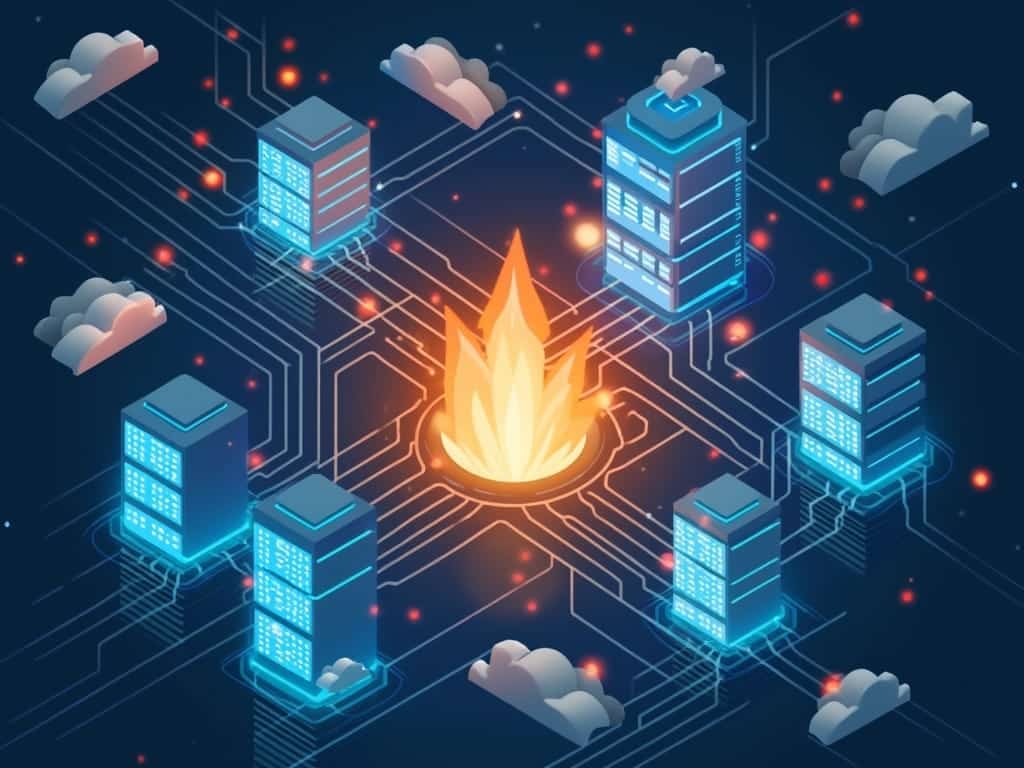Disaster Recovery as a Service (DRaaS) delivers cloud-based data protection through continuous server replication and automated recovery. This approach converts disaster recovery from a capital expense into an operational cost, making advanced protection available to organizations of all sizes without requiring costly secondary data centers.
Key Takeaways:
- Automated server replication with instant failover capabilities, delivering faster recovery times compared to legacy backup methods
- The service runs on a pay-as-you-go model, cutting upfront costs by 40-60% versus traditional disaster recovery solutions
- Recovery Time Objectives (RTO) and Recovery Point Objectives (RPO) establish the core DRaaS agreements, with select platforms achieving RPOs under 4 hours
- Comprehensive features include automated monitoring systems, regular testing environments, and expert 24/7 management
- Strong encryption and compliance standards (such as HIPAA, GDPR, and SOC 2) guarantee data security during backup and recovery operations
What is DRaaS (Disaster Recovery as a Service)?
Core Components and Definition
DRaaS is a cloud-based backup system that protects your data and maintains business operations during disruptions. This service moves beyond traditional physical backup sites by offering continuous server replication and automated recovery processes. Instead of investing in expensive secondary data centers, organizations can subscribe to DRaaS solutions that handle their disaster recovery needs.
Essential Features and Benefits
The primary elements that make DRaaS effective include:
- Automated server replication that creates real-time copies of your systems
- Instant failover capabilities to maintain business operations
- Cloud-based infrastructure that scales with your needs
- Built-in testing environments to verify recovery procedures
- Pay-as-you-go pricing models that reduce upfront costs
These features transform disaster recovery from a capital expense into an operational cost, making advanced protection accessible to businesses of all sizes. By shifting responsibility to specialized providers, companies can focus on their core operations while maintaining comprehensive protection against potential disasters.
The flexibility of cloud computing allows DRaaS to adapt to changing business requirements without the limitations of physical infrastructure. This approach provides faster recovery times and better protection than traditional backup methods, while requiring less technical expertise from internal IT teams.

How DRaaS Functions in Practice
Data Replication and System Monitoring
DRaaS maintains business continuity through constant or scheduled data replication between your primary site and the provider’s infrastructure. I recommend setting up automated monitoring systems that can detect failures instantly, triggering immediate protective measures. Modern DRaaS platforms can achieve Recovery Point Objectives (RPO) of less than 4 hours, ensuring minimal data loss during disasters.
Failover and Recovery Process
The failover process kicks in automatically when system failures occur. Here’s what happens during a typical DRaaS recovery:
- Data and applications shift to the backup infrastructure
- Virtual machines spin up in the cloud environment
- Network traffic redirects to the backup systems
- Applications resume operations with minimal disruption
Once the primary environment stabilizes, failback procedures transfer operations back to the original infrastructure. This process includes re-synchronizing any new data created during the outage and validating system integrity before switching back. Recovery Time Objectives (RTO) vary based on system complexity, but leading DRaaS providers can restore critical operations within hours rather than days.
The entire process runs through automated workflows, reducing human error and accelerating recovery speeds. Regular testing of these procedures ensures they’ll work as expected during actual emergencies.
Essential Components and Service Agreements
Recovery Objectives and SLAs
Recovery Point Objectives (RPO) and Recovery Time Objectives (RTO) form the foundation of any DRaaS agreement. RPO defines the maximum acceptable data loss measured in time, while RTO specifies how quickly systems must return to operation after a disaster.
Service Level Agreements lay out specific performance guarantees, including:
- Minimum uptime percentages for critical systems
- Response times during emergencies
- Data recovery success rates
- Financial penalties for missed targets
- Technical support availability
Security and Compliance Standards
DRaaS providers must maintain strict security protocols to protect sensitive data during backup and recovery processes. Advanced encryption safeguards data both in transit and at rest, while multi-factor authentication prevents unauthorized access. I recommend choosing providers that align with your industry’s compliance requirements:
- Healthcare organizations need HIPAA compliance
- Companies handling EU citizen data require GDPR certification
- Financial institutions often demand SOC 2 attestation
Regular security audits and penetration testing validate these protective measures. Your provider should actively maintain current compliance certifications and adapt security protocols as threats change. Modern DRaaS solutions incorporate automated compliance reporting to simplify regulatory documentation requirements.

Business Benefits and Cost Advantages
Financial Advantages
DRaaS delivers significant cost benefits through its pay-as-you-go model. I’ve found businesses can cut upfront expenses by 40-60% compared to traditional disaster recovery methods. You’ll eliminate the need for secondary data centers, hardware purchases, and maintenance staff. The service scales with your business growth, letting you adjust resources and costs based on real-time needs.
Operational Excellence
Expert teams handle your disaster recovery operations, providing constant monitoring and regular testing. Here’s what professional DRaaS management includes:
- 24/7 system monitoring and threat detection
- Automated backup scheduling and verification
- Regular disaster recovery testing and validation
- Quick response times during actual disasters
- Built-in compliance management
- Performance optimization and reporting
These features turn disaster recovery from a capital expense into an operating expense, making budgeting simpler while improving reliability.
Implementation Challenges
Technical and Business Hurdles
I’ve found that bandwidth management stands as a critical obstacle in DRaaS deployment. Large-scale data replication can strain network resources, requiring careful planning of bandwidth allocation. Setting up dedicated connections or scheduling replication during off-peak hours helps balance regular business operations with recovery needs.
Data volume poses another significant challenge. Here are key considerations for managing your data effectively:
- Implement data classification to prioritize critical vs non-critical information
- Set up incremental backups to reduce bandwidth usage
- Define retention policies aligned with business requirements
- Monitor storage costs and adjust backup frequencies accordingly
Selecting the right vendor requires thorough evaluation of several factors. I recommend focusing on their track record, support capabilities, and compliance certifications. The vendor should demonstrate clear recovery time objectives (RTOs) and recovery point objectives (RPOs) that match your business needs.
Recovery planning goes beyond technical setup. Your DRaaS strategy must account for business impact through:
- Clear communication protocols during outages
- Defined roles and responsibilities for recovery teams
- Regular testing and validation procedures
- Documentation of recovery processes
By addressing these challenges early in the implementation process, you’ll create a more reliable disaster recovery solution that supports your business continuity goals.

Comparison with Traditional Solutions
DRaaS vs Traditional Recovery
Traditional disaster recovery needs hefty upfront investments in backup data centers and hardware. DRaaS eliminates these costs through cloud-based solutions. I’ve found that recovery times drop from days to hours with DRaaS, while setup takes minutes instead of months.
DRaaS vs BaaS Differences
Here’s what sets DRaaS apart from Backup as a Service:
- DRaaS provides complete system recovery and continuity, while BaaS focuses on data backup
- Recovery speed is faster with DRaaS due to instant failover capabilities
- DRaaS includes automated testing and monitoring
- Cloud integration in DRaaS supports multi-site replication
- BaaS costs less but offers limited recovery options
The flexibility of DRaaS means you’ll pay only for what you use, unlike traditional setups requiring constant maintenance and staffing. Cloud integration also enables quick scaling during peak demands or emergencies.
Sources:
IBM
VMware
Cloudian
TechTarget
Nutanix
Veeam
Rubrik
CDW – “Why It’s Time to Consider Disaster Recovery as a Service”
Related Posts

Mobile Device Management: Enhancing Security and Productivity
Mobile Device Management: Enhancing Security and Productivity Mobile device management (MDM) is a crucial aspect of modern business operations. MDM allows organizations to efficiently manage, secure,

What is the Difference Between IT Outsourcing and Managed Services? Explained Clearly
Technology support comes in two primary forms: IT outsourcing and managed services. Outsourcing tackles specific projects or tasks, while managed services deliver complete IT support

MSP vs MSSP: Understanding the Differences in IT Services
MSP vs MSSP: Understanding the Differences in IT Services When it comes to managing IT services, businesses often find themselves choosing between a Managed Service
